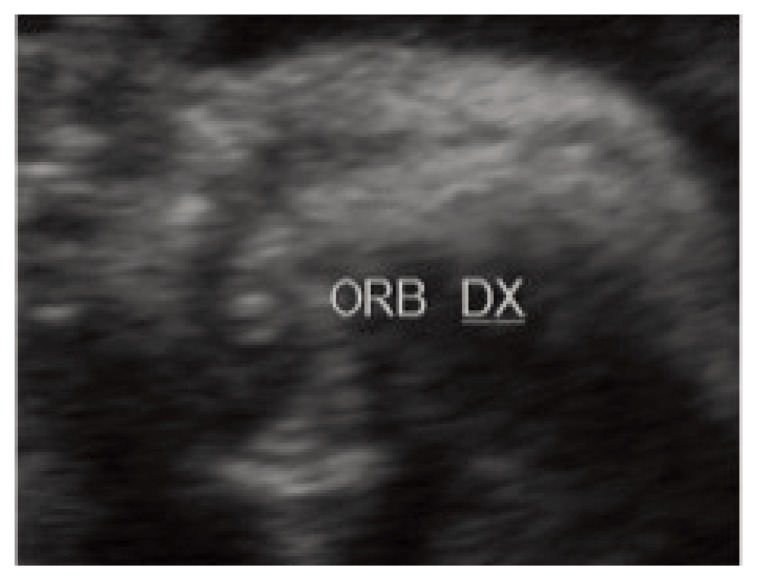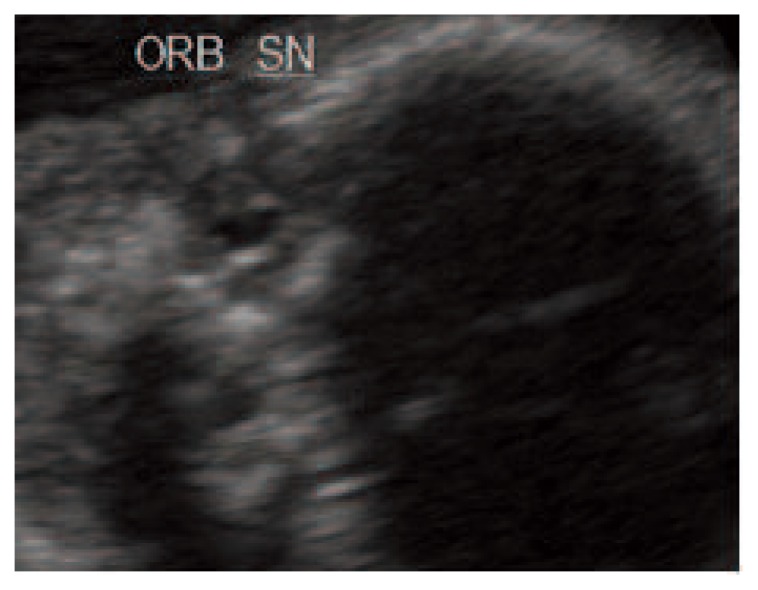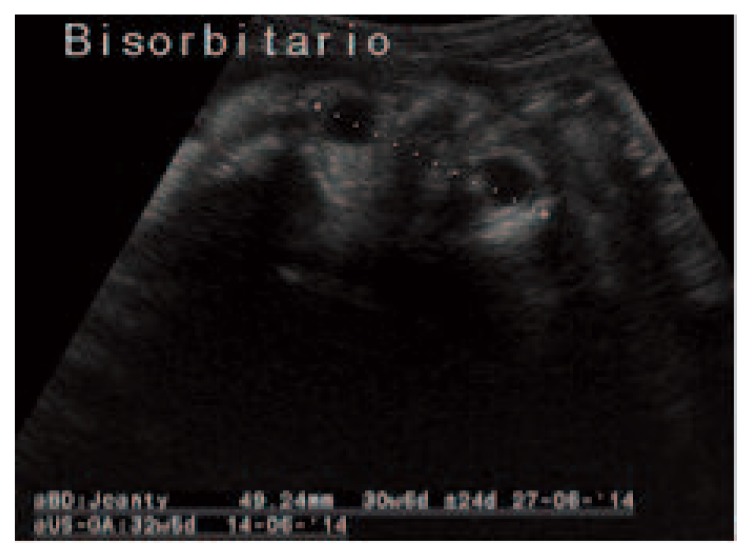Abstract
Introduction
the ultrasound prenatal diagnosis of aphakia is a difficult diagnosis and often requires a genetic study of the karyotype.
Case report
we present a rare case of prenatal bilateral aphakia, confirmed after bird. The patient was observed by ultrasound during the 23rd week of pregnancy. Through transabdominal ultrasound the lens could not be visualized bilaterally. The remaining anathomy, explorable by ultrasound, was still regular. When aphakia is suspected, genetic counseling is essential.
Conclusion
a differential diagnosis between aphakia and anophtalmia is necessary. A TORCH complex evaluation can be useful. Amniocentesis is always required.
Keywords: congenital aphakia, lens, anterior segment of the eye, ultrasound, prenatal diagnosis
Introduction
Congenital aphakia is a rare anomaly. There are two pathology pathways: primary type and secondary type. Primary congenital aphakia is a rare development disorder, characterized by the absence of lens developed between the 4th and the 5th week of embryogenesis. The absence of these structures implies total aplasia of the anterior segment of the eye, which is the histological criterion for the diagnosis. Secondary aphakia concerning in partial development of the lens due to late reabsorption or eventually due to expulsion through a corneal perforation (1). A study of Valleix et al. (2006) identified homozygous mutation of FOXE3 gene on 1p33 chromosome in three brothers with aphakia born by consanguineous parents. A heterozygosis mutation of FOXE3 gene is associated with dysgenesis of anterior segment of the eye and cataract. The incidence is 1–5/10.000, with autosomal recessive transmission. Congenital aphakia is often associated with other secondary eye abnormalities such as aplasia/dysplasia of the anterior chamber of the eye, microphtalmia, absence of the iris, retina dysplasia (1, 2).
Case Report
A 26-year-old woman, during the first pregnancy, was observed by ultrasound during the 23rd week of pregnancy. The patient reported a negative familiar history for malformation and chromosomal disorders and a negative personal history of teratogens exposition. The pregnancy evolution was normal and fetal biometric was regular. Through transabdominal ultrasound, during the study of orbital cavities, the lens could not be visualized bilaterally (Figs. 1, 2). At this point bisorbital diameter was in the 25th percentile. The remaining anatomy, explorable by ultrasound in this period, was regular.
Figure 1.
Absence of the right lens.
Figure 2.
Absence of the left lens.
During an ultrasound control within easy reach, bilaterally absence of the lens was confirmed; small muscle movements were observed in the orbital cavities. Through ultrasound it is possible to confirm the diagnosis of aphakia without excluding the diagnosis of anophthalmia. During an ultrasound control at 33rd week of pregnancy the bilateral lens abscence is further confirmed. The bisorbital diameter was now reduced under the 1st percentile (Fig. 3). The remaining anathomy, explorable by ultrasound, was still regular. These data are strongly suggestive of a diagnosis of congenital primary anophtalmia.
Figure 3.
Reduced bisorbital diameter.
Discussion
When it is not possible to visualize the lens by ultrasound a differential diagnosis between aphakia and anophtalmia (complete absence of the eye) is necessary. This differential diagnosis is not possible by ultrasound and can only be confirmed after birth. When aphakia is suspected, we recommend a genetic counseling (FOXE3 gene on 1p33 chromosome, SOX2, PAX6) and an ophthalmology specialist consulting (3).
Finally we suggest to exclude the presence of rubella infection due to multiple correlation between aphakia and other malformations produced by rubella virus. Therefore a TORCH complex evaluation can be useful. Amniocentesis is always required (4).
Footnotes
The Authors report no conflict of interest.
The Authors attest that they have obtained written consent from the patient.
References
- 1.Valleix S, Niel F, Nedelec B, Algros MP, Schwartz C, Delbosc B, Delpech M, Kantelip B. Homozygous nonsense mutation in the FOXE3 gene as a cause of congenital primary aphakia in humans. Am J Hum Genet. 2006 Aug;79(2):358–364. doi: 10.1086/505654. Epub 2006 Jun 8. [DOI] [PMC free article] [PubMed] [Google Scholar]
- 2.Ali M, Buentello-Volante B, McKibbin M, Rocha-Medina JA, Fernandez-Fuentes N, Koga-Nakamura W, Ashiq A, Khan K, Booth AP, Williams G, Raashid Y, Jafri H, Rice A, Inglehearn CF, Zenteno JC. Homozygous FOXE3 mutations cause non-syndromic, bilateral, total sclerocornea, aphakia, microphthalmia and optic disc coloboma. Mol Vis. 2010 Jun 23;16:1162–1168. [PMC free article] [PubMed] [Google Scholar]
- 3.Gould DB, Smith RS, John SW. Anterior segment development relevant to glaucoma. Int J Dev Biol. 2004;48(8–9):1015–1029. doi: 10.1387/ijdb.041865dg. [DOI] [PubMed] [Google Scholar]
- 4.Vermeif-Keers C. Primary congenital aphakia and the rubella syndrome. Teratology. 1975 Jun;11(3):257–265. doi: 10.1002/tera.1420110305. [DOI] [PubMed] [Google Scholar]





